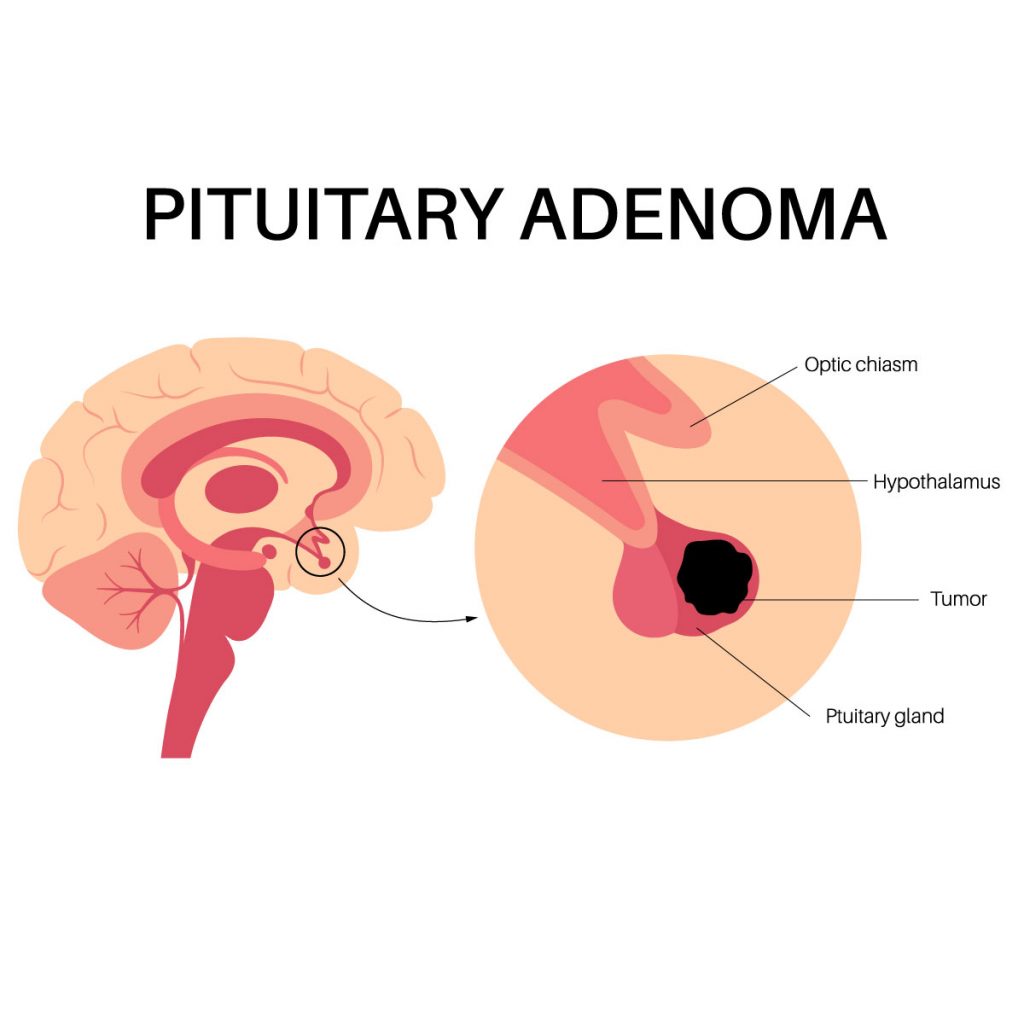
Pituitary Tumors


Overview
The abnormal growth of tumor that occur at the pituitary gland is called pituitary tumor. The pituitary gland is a small gland that is about the size of a pea, it connects to the hypothalamus, just behind the nose. It has two lobes, the anterior lobe and posterior lobe that releases different hormones.
Pituitary adenomas are noncancerous type of tumor and doesn’t spread to other parts of the body, however they could pose a risk in the functionality of the pituitary gland and cause risk to the health. Pituitary gland’s ability to produce hormones may be affected by some pituitary tumors. Hormones that control vital bodily processes are produced in excess by some pituitary tumors.
There are different kinds of treatment for pituitary tumors, such as surgical removal of the tumor, and medications to control hormone levels. It is recommended to have a consultation with the specialist for proper diagnosis.
Categories of pituitary adenomas according to secretion:
- Functioning adenomas (secreting): Pituitary tumors can produce an excessive level of hormones. Functional adenomas includes:
- Prolactinoma: a tumor that overproduces prolactin.
- Somatotroph adenoma: a tumor that overproduces growth hormone that will cause acromegaly.
- Corticotroph adenoma: a tumor that overproduces adrenocorticotropic hormone (ACTH) that cause will Cushing’s syndrome.
- Thyrotroph adenomas: a tumor that overproduces thyroid-stimulating hormone (TSH) that will cause hyperthyroidism.
- Gonadotroph adenomas: a tumor that overproduces gonadotropin hormones.
- Nonfunctioning adenomas (non-secreting): Pituitary tumors that do not produce any hormones. But if they become large, they can become mass effect and compress nearby structure.
Categories of Pituitary adenomas according to size:
- Microadenomas: Their size is smaller than 10 millimeters.
- Macroadenomas: Their size is over 10 millimeters. Macroadenomas occur as common compared to microadenomas. They are also more likely to result in hypopituitarism, which is characterized by lower hormone level compared to normal.
Symptoms
Some pituitary glands do not show any signs or symptoms. Depending on the production of hormone, pituitary tumors that are functioning might result in a different kind of signs and symptoms. Occasionally the pituitary tumors are discovered by incidental finding during an imaging examination like an MRI or CT that was done for another purpose. Pituitary tumors that are growing and putting pressure on other structures are related to the signs and symptoms of non-producing hormones (nonfunctioning) pituitary tumors.
Signs and symptoms (tumor pressure)
The following signs and symptoms result from the large size tumor’s pressure on the pituitary tumor:
- Vision problems
- Headaches
Signs and symptoms (hormonal deficiency)
Pituitary macroadenomas can harm the tissue of the pituitary gland, which can result in one or more pituitary hormone deficits. Hypopituitarism, or an underactive pituitary gland, may occur and present with the following symptoms.
- Luteinizing Hormone (LH) and Follicle Stimulating Hormone (FSH) deficiency: hypogonadism, a condition marked by low levels of both estrogen (FSH) and testosterone (LH), results.
- Hot flashes
- Vaginal dryness
- Erectile dysfunction in men
- Reduced facial/body hair development in male.
- Mood swings
- Loss of libido
- Thyroid Stimulating Hormone (TSH) deficiency: condition marked by low thyroid hormone production called hypothyroidism with the following symptoms:
- Fatigue or weakness
- Constipation
- Slow heartbeat
- Dry skin
- Swelling of extremities
- Slower reflexes.
- Adrenocorticotropic hormone-secreting (ACTH) deficiency: is a decrease in cortisol production which called adrenal insufficiency. Symptoms are the following:
- Low blood pressure
- Nausea and vomiting
- Abdominal pain
- Poor appetite.
- Growth Hormone deficiency: low production of growth hormone. Symptoms depend on the age of the patient.
- Fatigue
- Weakness
- Decrease in the muscle mass
Signs and symptoms (overproduction of hormone)
Some pituitary adenoma overproduce one or more pituitary hormones, known as hyperpituitarism. The symptoms of hyperpituitarism vary depend on the affected hormones.
- Adrenocorticotropic hormone-secreting (ACTH) tumors: is an increase in cortisol production which called Cushing syndrome. Symptoms are the following:
- Rounded face
- Increased fat around the neck
- High blood pressure
- High blood sugar
- Purple stretch marks over the belly
- Easy bruising
- Muscle weakness
- Osteoporosis
- Growth hormone-secreting tumors (somatotroph adenoma): excessive secretion of growth hormone. Symptoms depend on the age of the patient.
- In adult, excessive secretion of growth hormones cause a condition called acromegaly. Symptoms are the following:
- Joint aches and pain
- Enlarged hands and feet
- Excessive sweating
- Heart problems
- Facial changes
- In children, excessive secretion of growth hormones causes a condition called gigantism. Symptoms are the following:
- Gaps between the teeth
- Large hands and feet
- Enlargement of the forehead, jaw, and nose
- In adult, excessive secretion of growth hormones cause a condition called acromegaly. Symptoms are the following:
- Prolactin-secreting tumors: pituitary tumor that causes excessive secretion of prolactin called prolactinoma. This result in a decreased level of sex hormones.
- In women, prolactinoma can cause:
- Irregular menstrual period or no menstrual period
- Milk discharge from breast (when not pregnant/breast feeding)
- In men, prolactinoma can cause:
- Loss of interest in sexual activity
- Enlarged breast
- Decreased sperm production
- In women, prolactinoma can cause:
- Thyroid-stimulating hormone-secreting tumors: excessive secretion of thyroid-stimulating hormone (TSH) causes a condition called hyperthyroidism. Symptoms are the following:
- Unexplained weight loss
- Rapid heartbeat
- Excessive sweating
- Irritability
Consult the doctor if patient experience any signs or symptoms that could point to a pituitary tumor. Pituitary tumors are frequently treatable, allowing your hormone levels to return to normal and reducing its symptoms.
Talk to the doctor about routine testing that could aid in the early detection of a pituitary tumor if multiple endocrine neoplasia type 1 (MEN 1) runs in the family.
Causes
It is unclear what causes the pituitary gland’s uncontrolled cell development, which results in tumors.
A small, bean-shaped gland called the pituitary gland is found at the base of the brain, between the ears and behind the nose. The gland affects the functioning of the body despite its small size. It generates hormones that control vital processes like growth, blood pressure, and reproduction.
Most cases of pituitary tumors lack any obvious hereditary component, while a small percentage run in families. The development of pituitary tumors is thought to be significantly influenced by genetic changes.
Risk factors
A higher risk of pituitary tumor exists in those who have a family history of specific genetic diseases. Additional hereditary disorders linked to pituitary adenomas include:
- Multiple endocrine neoplasia type 1 (MEN 1)
- Multiple endocrine neoplasia type 4 (MEN 4)
- Neurofibromatosis type 1
- Carney complex
- X-LAG syndrome
- Succinate dehydrogenase-related familial pituitary adenoma
- Von Hippel-Lindau syndrome
Contact Information
service@vejthani.com






















